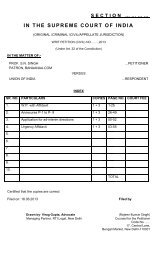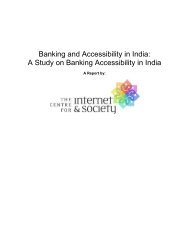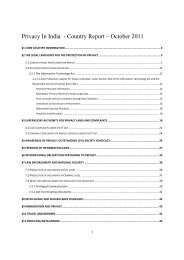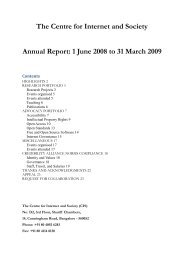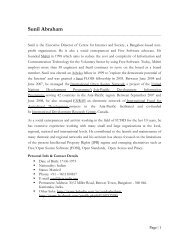Open Access to Scholarly Literature in India - Centre for Internet and ...
Open Access to Scholarly Literature in India - Centre for Internet and ...
Open Access to Scholarly Literature in India - Centre for Internet and ...
You also want an ePaper? Increase the reach of your titles
YUMPU automatically turns print PDFs into web optimized ePapers that Google loves.
t<strong>in</strong>ues <strong>to</strong> be poor. Year after year, studies carried out by the Research Group of Thomson<br />
Reuters show that <strong>in</strong> no field <strong>India</strong>n research publications have been cited more than the<br />
world average, as shown <strong>in</strong> Table 3.<br />
(That is not <strong>to</strong> say that all papers from <strong>India</strong> are poorly cited. Surely there are<br />
outst<strong>and</strong><strong>in</strong>g scientists whose papers have won a very large number of citations as shown<br />
by Madhan et al. 27 . What we are talk<strong>in</strong>g about is the national average.) Also, as most <strong>India</strong>n<br />
journals are not <strong>in</strong>dexed <strong>in</strong> SCI, are not assigned impact fac<strong>to</strong>r, <strong>and</strong> do not have a<br />
large subscriber base, papers published <strong>in</strong> them are not read by many. Table 4 lists the<br />
impact fac<strong>to</strong>rs of 35 <strong>India</strong>n journals as seen from the 2009 edition of Journal Citation<br />
Reports. Only three titles have an impact fac<strong>to</strong>r greater than 1.00. Clearly, <strong>India</strong>n science<br />
has a visibility problem.<br />
To overcome this problem, many <strong>India</strong>n publishers are ty<strong>in</strong>g up with western<br />
publish<strong>in</strong>g companies. Almost <strong>in</strong> all such cases the <strong>in</strong>itiative has come from the western<br />
publishers who want <strong>to</strong> enlarge the collection of journals under their banner. For<br />
example, a few years ago Spr<strong>in</strong>ger approached the <strong>India</strong>n Academy of Sciences, which<br />
publishes n<strong>in</strong>e research journals <strong>and</strong> a popular science journal aimed at students, <strong>and</strong> successfully<br />
negotiated an agreement <strong>to</strong> market the Academy's journals outside <strong>India</strong>. A<br />
similar ef<strong>for</strong>t by the Nature Publish<strong>in</strong>g Group <strong>for</strong> a tie-up with Current Science did not<br />
go through. There have also been ef<strong>for</strong>ts <strong>to</strong> buy out journals published by <strong>India</strong>n commercial<br />
publishers <strong>and</strong> even <strong>to</strong> take over <strong>India</strong>n publish<strong>in</strong>g companies.<br />
Now that we know where <strong>India</strong>n science st<strong>and</strong>s - low but <strong>in</strong>creas<strong>in</strong>g research<br />
productivity helped by <strong>in</strong>creas<strong>in</strong>g <strong>in</strong>vestments on R&D, <strong>and</strong> low but moderately<br />
improv<strong>in</strong>g visibility — what should we do? The answer is simple: adopt open access as a<br />
national policy. Adoption of open access alone can improve visibility <strong>and</strong> impact of<br />
<strong>India</strong>n science, <strong>and</strong> we should encourage the rest of the world <strong>to</strong> adopt open access so we<br />
can access relevant research <strong>in</strong><strong>for</strong>mation.<br />
27 Supra note 21.<br />
Page | 15




